parking brake CHEVROLET CAMARO 1998 4.G Owners Manual
[x] Cancel search | Manufacturer: CHEVROLET, Model Year: 1998, Model line: CAMARO, Model: CHEVROLET CAMARO 1998 4.GPages: 402, PDF Size: 21.2 MB
Page 69 of 402
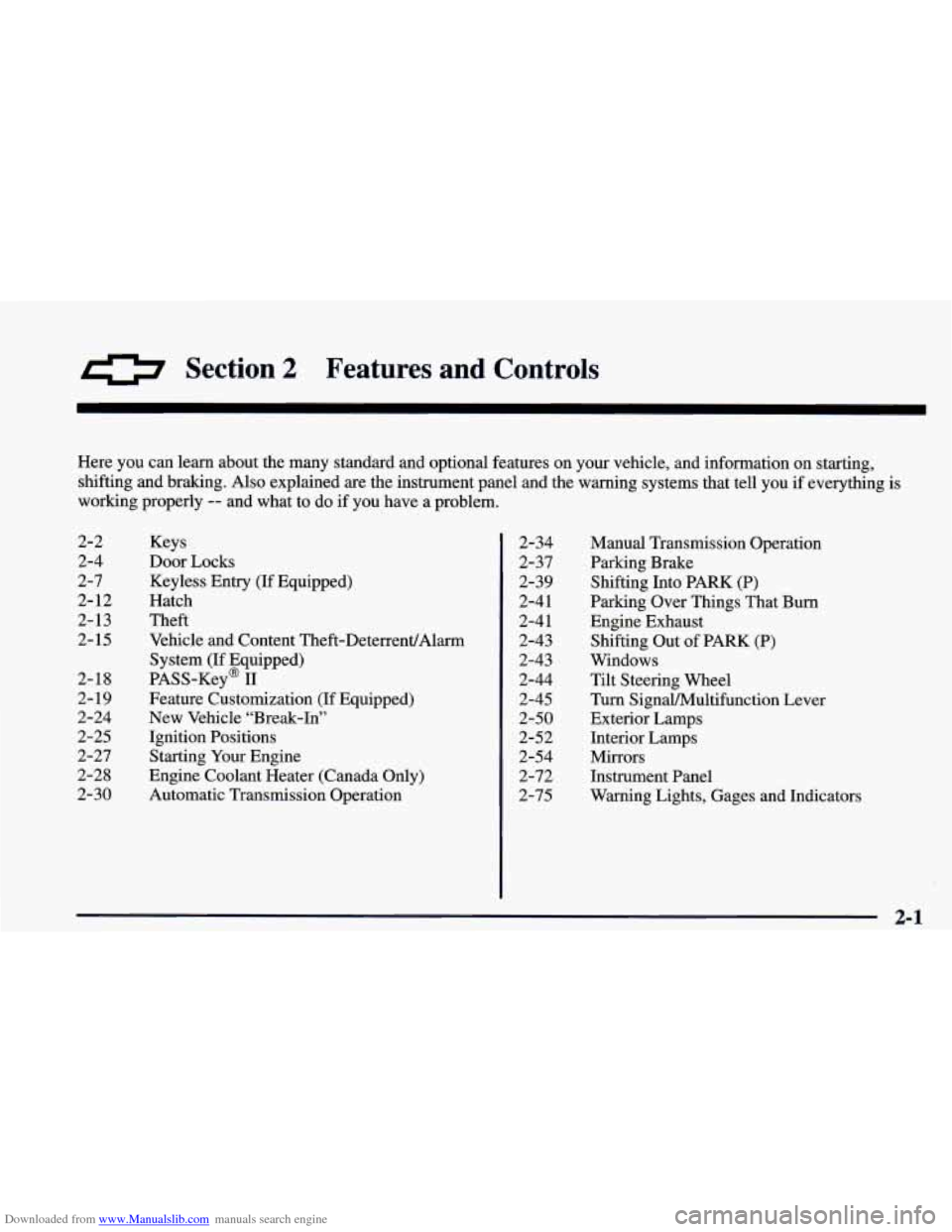
Downloaded from www.Manualslib.com manuals search engine 0 Section 2 Features and Controls
Here you can learn about the many standard and optional features on your vehicle, and information on starting,
shifting and braking.
Also explained are the instrument panel and the warning systems that tell you if everything is
working properly -- and what to do if you have a problem.
2-2
2-4
2-7
2- 12
2- 13
2- 15
2-18
2-19
2-24
2-25
2-27
2-28
2-30 Keys
Door Locks
Keyless Entry
(If Equipped)
Hatch
Theft
Vehicle and Content Theft-DeterrenVAlarm
System (If Equipped)
PASS-Key@
I1
Feature Customization (if Equipped)
New Vehicle “Break-In”
Ignition Positions
Starting Your Engine
Engine Coolant Heater (Canada Only)
Automatic Transmission Operation 2-34
2-37
2-39 2-4 1
2-4
1
2-43
2-43
2-44
2-45
2-50
2-52
2-54
2-72
2-75
Manual Transmission Operation
Parking Brake Shifting Into PARK (P)
Parking Over Things That Bum
Engine Exhaust Shifting Out
of PARK (P)
Windows
Tilt Steering Wheel
Turn SignaVMultifunction Lever
Exterior Lamps
Interior Lamps
Mirrors
Instrument Panel
Warning Lights, Gages and Indicators
2-1
Page 76 of 402
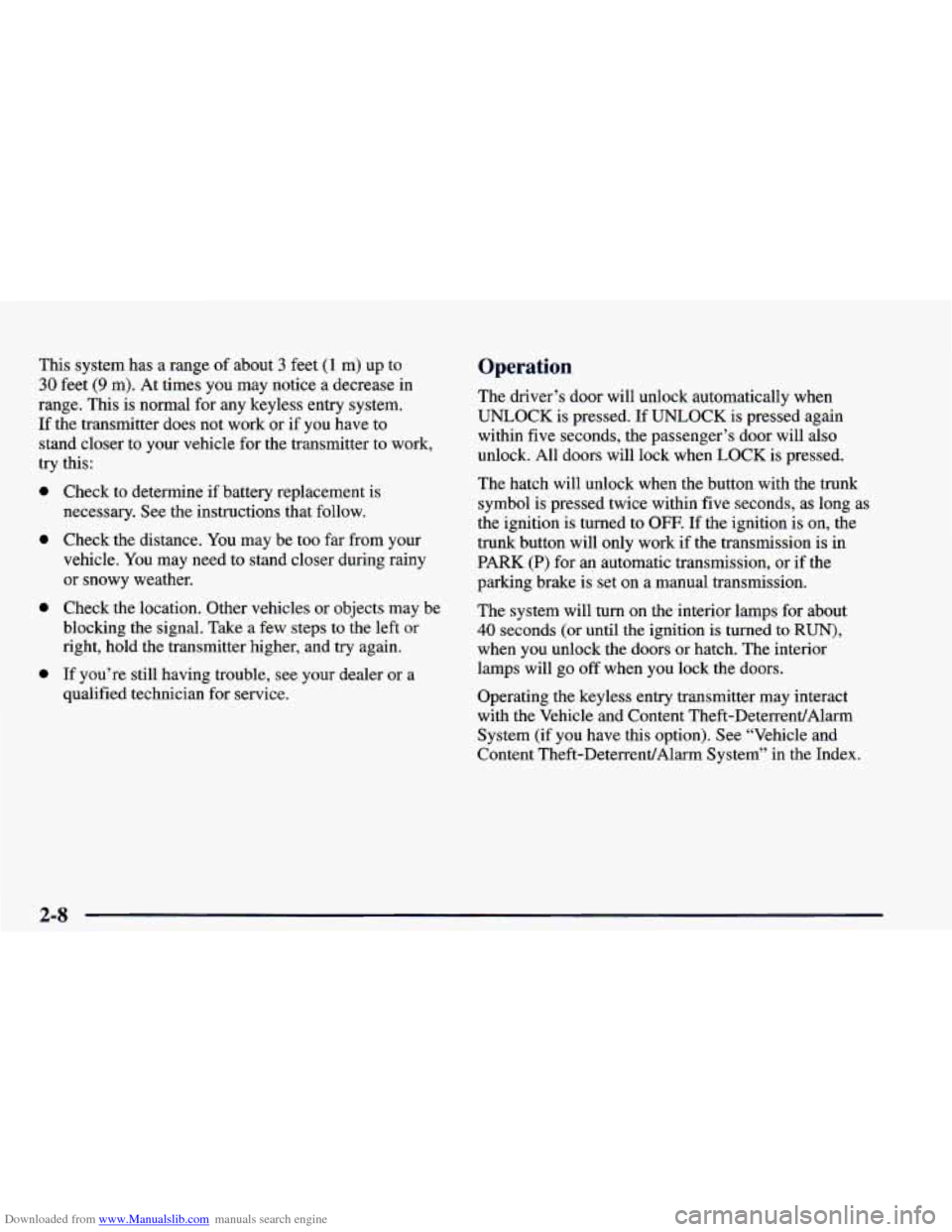
Downloaded from www.Manualslib.com manuals search engine This system has a range of about 3 feet (1 m) up to
30 feet (9 m). At times you may notice a decrease in
range. This is normal for any keyless entry system.
If the transmitter does not work
or if you have to
stand closer to your vehicle for the transmitter to work,
try this:
0
0
0
0
Check to determine if battery replacement is
necessary. See the instructions that follow.
Check the distance. You may be too far from your
vehicle.
You may need to stand closer during rainy
or snowy weather.
Check the location. Other vehicles or objects may be
blocking the signal. Take
a few steps to the left or
right, hold the transmitter higher, and try again.
If you’re still having trouble, see your dealer or a
qualified technician
for service.
Operation
The driver’s door will unlock automatically when
UNLOCK is pressed. If UNLOCK
is pressed again
within five seconds, the passenger’s door will also
unlock. All doors will lock when LOCK
is pressed.
The hatch will unlock when the button with the trunk
symbol is pressed twice within five seconds,
as long as
the ignition is turned to OFF. If the ignition is on, the
trunk button will only work
if the transmission is in
PARK (P) for an automatic transmission, or if the
parking brake is. set on
a manual transmission.
The system will turn on the interior lamps for about
40 seconds (or until the ignition is turned to RUN),
when you unlock the doors or hatch. The interior
lamps will go
off when you lock the doors.
Operating the keyless entry transmitter may interact
with the Vehicle and Content Theft-DeterrendAlarm System (if you have this option). See “Vehicle and
Content Theft-DeterrendAlarm System’’ in the Index.
2-8
Page 81 of 402
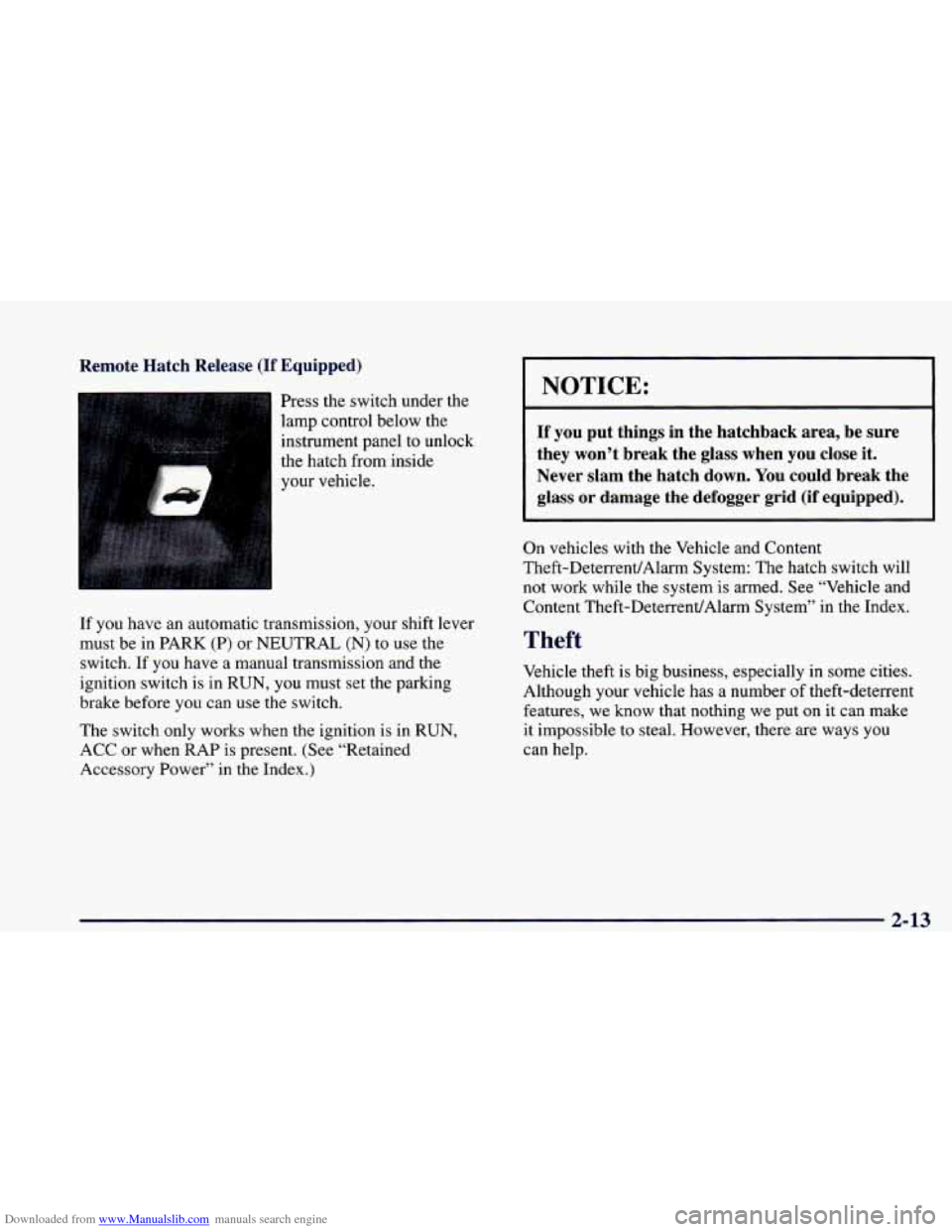
Downloaded from www.Manualslib.com manuals search engine Remote Hatch Release (If Equipped)
Press the switch under the
lamp control below the
instrument panel
to unlock
the hatch from inside
your vehicle. I
If you have an automatic transmission, your shift lever
must be in PARK
(P) or NEUTRAL (N) to use the
switch. If you have a manual transmission and the
ignition switch is in RUN,
you must set the parking
brake before you can use the switch.
The switch only works when the ignition
is in RUN,
ACC
or when RAP is present. (See “Retained
Accessory Power” in the Index.)
I NOTICE:
If you put things in the hatchback area, be sure
they won’t break the glass when you close it.
Never slam the hatch down. You could break the
glass
or damage the defogger grid (if equipped).
On vehicles with the Vehicle and Content
Theft-DeterrenUAlarm System: The hatch switch will not work while the system is armed. See “Vehicle and
Content Theft-Deteuent/Alarm System” in the Index.
Theft
Vehicle theft is big business, especially in some cities.
Although your vehicle has
a number of theft-deterrent
features, we
know that nothing we put on it can make
it impossible to steal. However, there
are ways you
can help.
2-13
Page 98 of 402
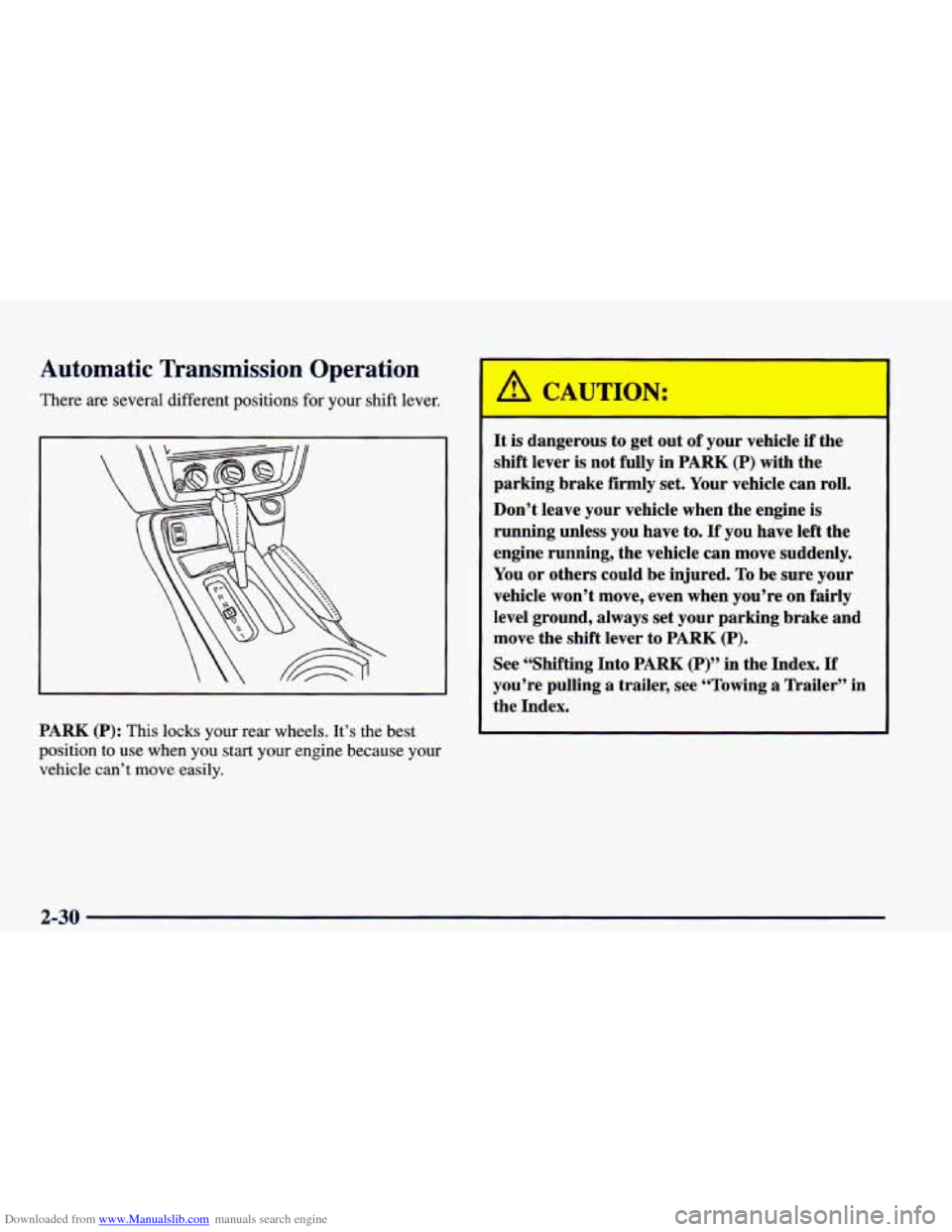
Downloaded from www.Manualslib.com manuals search engine Automatic Transmission Operation
There are several different positions for your shift lever.
PARK (P): This locks your rear wheels. It’s the best
position to
use when you start your engine because your
vehicle can’t move easily.
It is dangerous to get out or your vehicle if the
shift lever is not fully in
PARK (P) with the
parking brake firmly set. Your vehicle can roll.
Don’t leave
your vehicle when the engine is
running unless you have to.
If you have left the
engine running, the vehicle can move suddenly.
You or others could be injured.
To be sure your
vehicle won’t move, even when you’re on fairly
level ground, always set your parking brake and
move the shift lever to
PARK (P).
See “Shifting Into PARK (P)” in the Index. If
you’re pulling a trailer, see “Towing
a Trailer” in
the Index.
2-30
Page 102 of 402
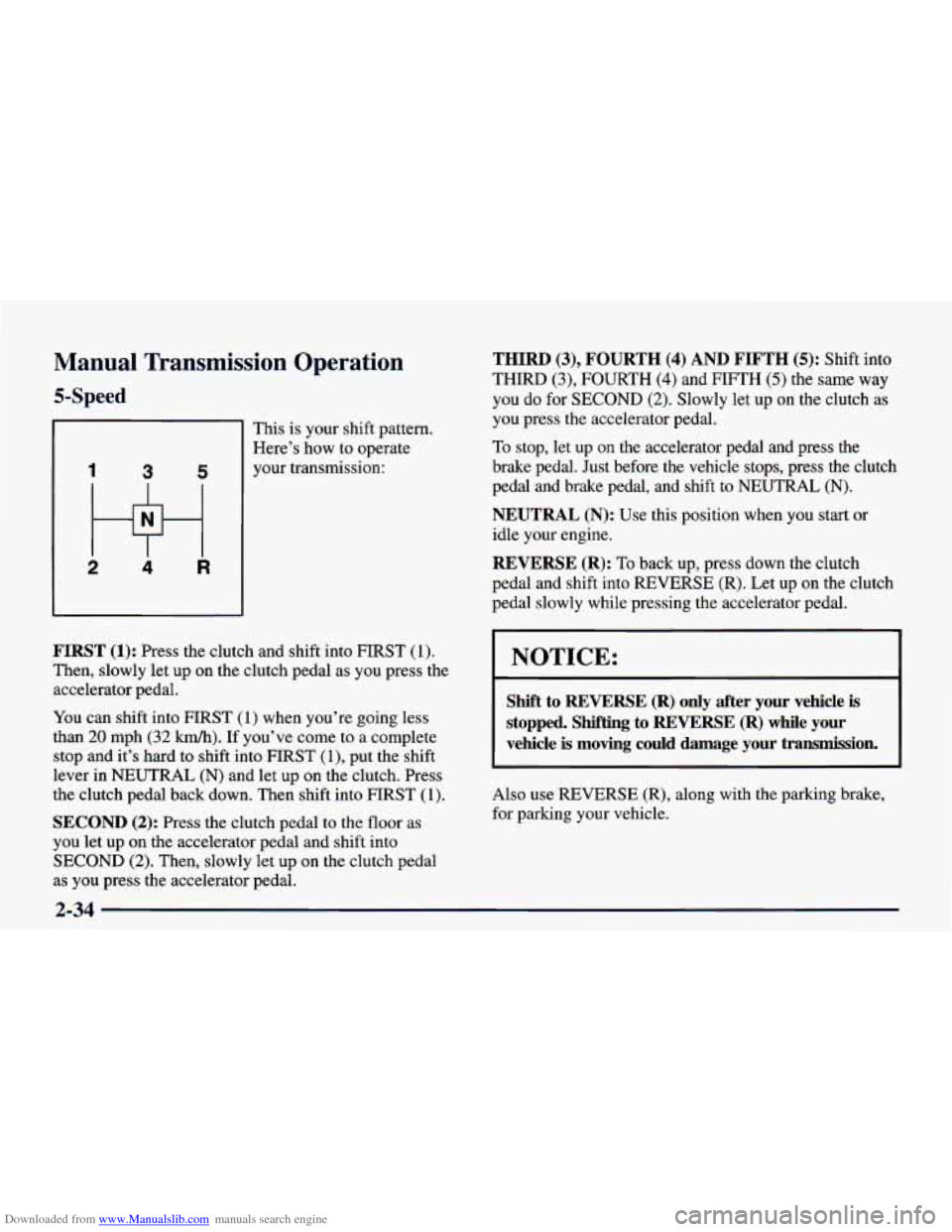
Downloaded from www.Manualslib.com manuals search engine Manual Transmission Operation
5-Speed
I 3 5
2 4 R
This is your shift pattern.
Here’s how to operate
your transmission:
FIRST (1): Press the clutch and shift into FIRST (1).
Then, slowly let up on the clutch pedal as you press the
accelerator pedal.
You can shift into
FIRST (I) when you’re going less
than
20 mph (32 km/h). If you’ve come to a complete
stop and it’s hard to shift into FIRST
(1), put the shift
lever in NEUTRAL (N) and let up on the clutch. Press
the clutch pedal back down. Then shift into FIRST
(1).
SECOND (2): Press the clutch pedal to the floor as
you let up on the accelerator pedal and shift into
SECOND
(2). Then, slowly let up on the clutch pedal
as you press the accelerator pedal.
THIRD (3), FOURTH (4) AND FIFTH (5): Shift into
THIRD
(3), FOURTH (4) and FIFTH (5) the same way
you do for
SECOND (2). Slowly let up on the clutch as
you press the accelerator pedal.
To stop,
let up on the accelerator pedal and press the
brake pedal. Just before the vehicle stops, press the clutch
pedal and brake pedal, and shift to NEUTRAL
(N).
NEUTRAL (N): Use this position when you start or
idle your engine.
REVERSE (R): To back up, press down the clutch
pedal and shift into
REVERSE (R). Let up on the clutch
pedal slowly while pressing the accelerator pedal.
NOTICE:
Shift to REVERSE (R) only after your vehicle is
stopped. Shifting to REVERSE (R) while your
vehicle
is moving could damage your transmission.
L
Also use REVERSE (R), along with the parking brake,
for parking your vehicle.
Page 105 of 402
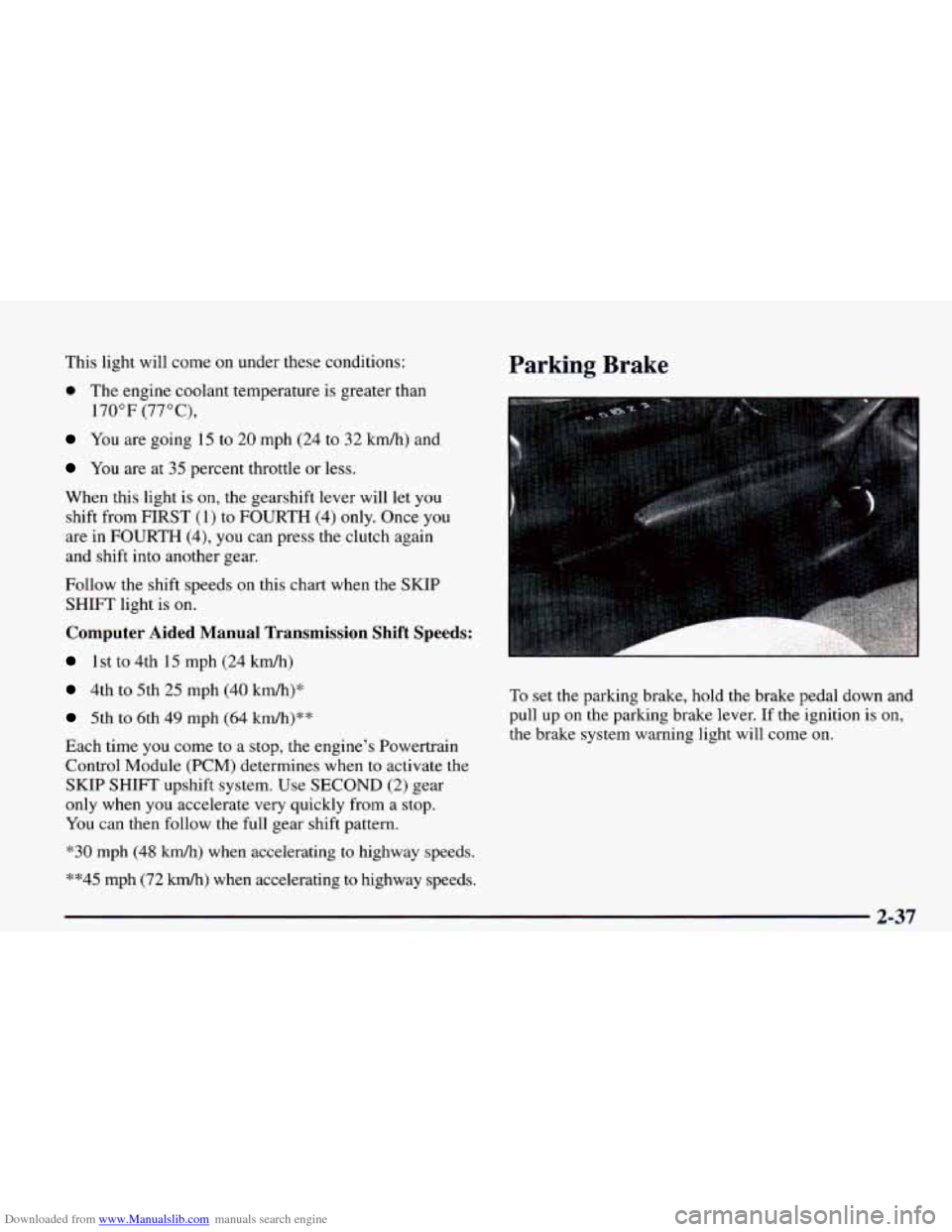
Downloaded from www.Manualslib.com manuals search engine This light will come on under these conditions:
0 The engine coolant temperature is greater than
170°F (77"C),
You are going 15 to 20 mph (24 to 32 km/h) and
You are at 35 percent throttle or less.
When this light is on, the gearshift lever will let you
shift from FIRST (1) to FOURTH (4) only. Once you
are in FOURTH (4), you can press the clutch again
and shift into another gear.
Follow the shift speeds on this chart when the
SKIP
SHIFT light is on.
Computer Aided Manual Transmission Shift Speeds:
1st to 4th 15 mph (24 kdh)
4th to 5th 25 mph (40 km/h)*
5th to 6th 49 mph (64 km/h)**
Each time you come
to a stop, the engine's Powertrain
Control Module (PCM) determines when to activate the
SKIP SHIFT upshift system. Use SECOND (2) gear
only when you accelerate very quickly from a stop.
You can then follow the full gear shift pattern.
"30 mph (48 km/h) when accelerating to highway speeds.
""45 mph (72 kmk) when accelerating to highway speeds.
Parking Brake
To set the parking brake, hold the brake pedal down and
pull up
on the parking brake lever. If the ignition is on,
the brake system warning light will come on.
2-37
Page 106 of 402
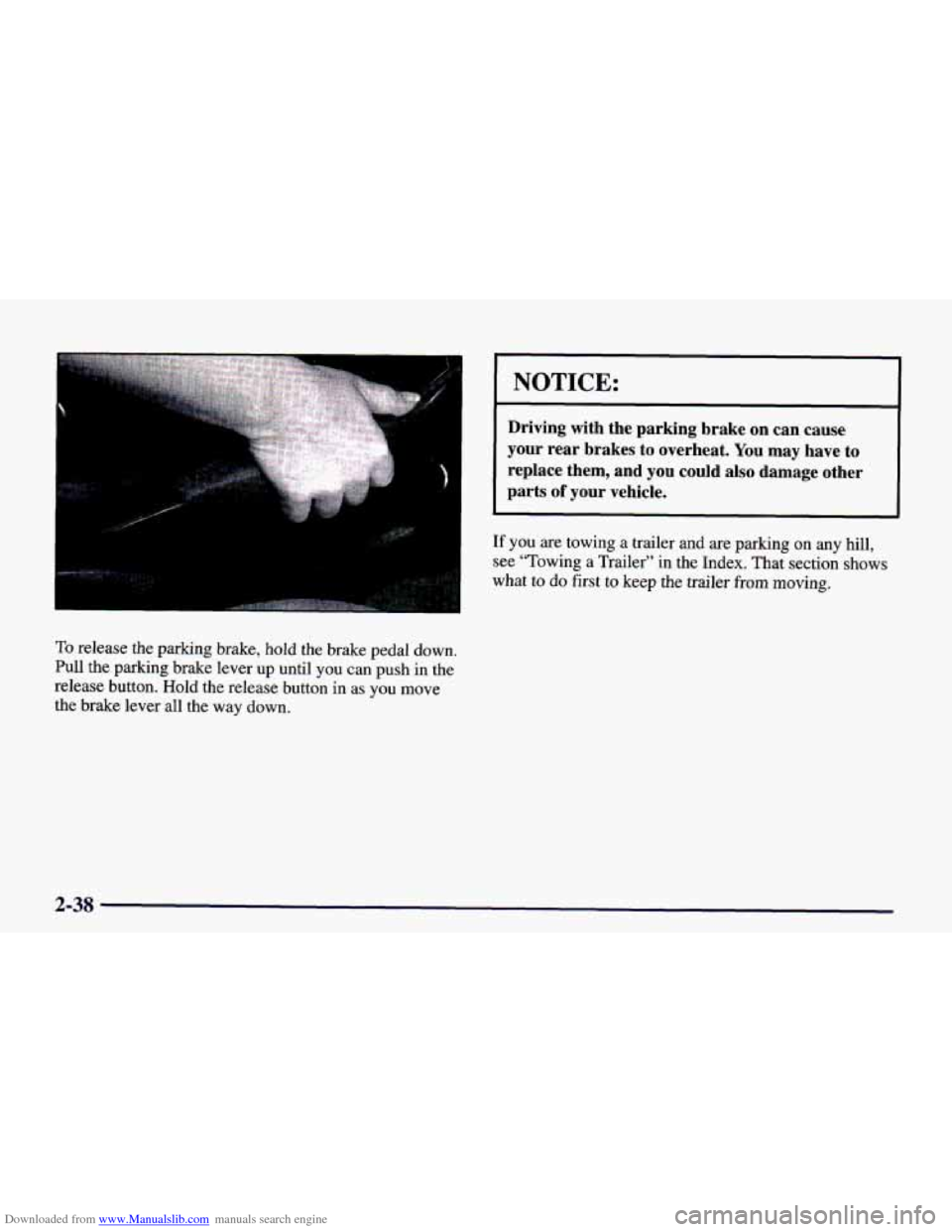
Downloaded from www.Manualslib.com manuals search engine To release the parking brake, hold the brake pedal down.
Pull the parking brake lever
up until you can push in the
release button. Hold
the release button in as you move
the brake lever all the way down.
NOTICE:
Driving with the parking brake on can cause
your rear brakes to overheat.
You may have to
replace them, and
you could also damage other
parts
of your vehicle.
.-
If you are towing a trailer and are parking on any hill,
see “Towing a Trailer” in the Index. That section shows
what to
do first to keep the trailer from moving.
2-38
Page 107 of 402
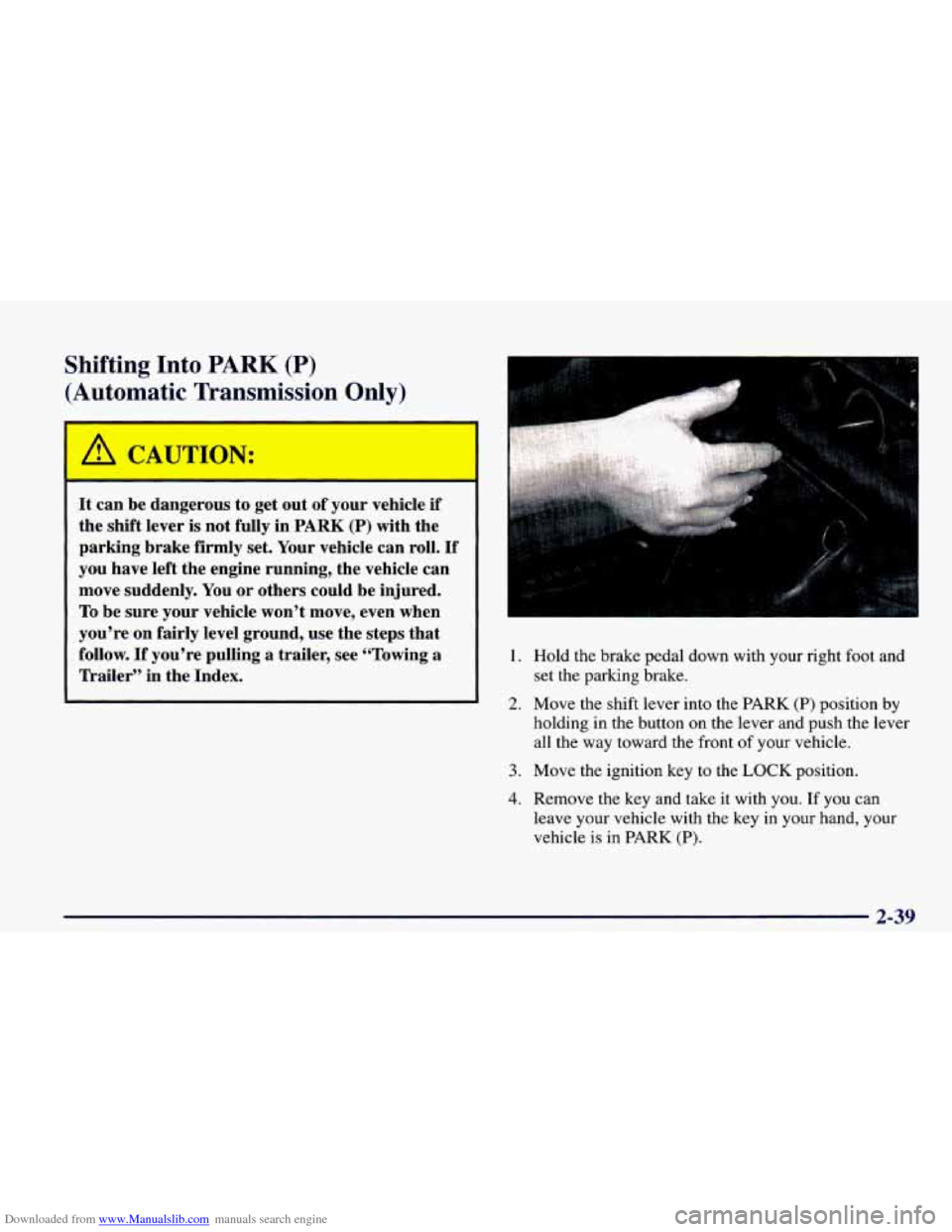
Downloaded from www.Manualslib.com manuals search engine Shifting Into PARK (P)
(Automatic Transmission Only)
A CAUTION:
It can be dangerous to get out of your vehicle if
the shift lever is not fully in PARK (P) with the
parking brake firmly set. Your vehicle can roll.
If
you have left the engine running, the vehicle can
move suddenly. You or others could be injured.
To be sure your vehicle won’t move, even when
you’re on fairly level ground, use the steps that
follow.
If you’re pulling a trailer, see “Towing a
Trailer” in the Index.
., .,. ..
..
1.
2.
3.
4.
Hold the brake pedal down with your right foot and
set the parking brake.
Move the shift lever into the PARK
(P) position by
holding in the button on the lever and push the lever
all the way toward the front
of your vehicle.
Move the ignition key to the
LOCK position.
Remove the key and take it with you.
If you can
leave your vehicle with the key in your hand, your
vehicle
is in PARK (P).
2-39
Page 108 of 402
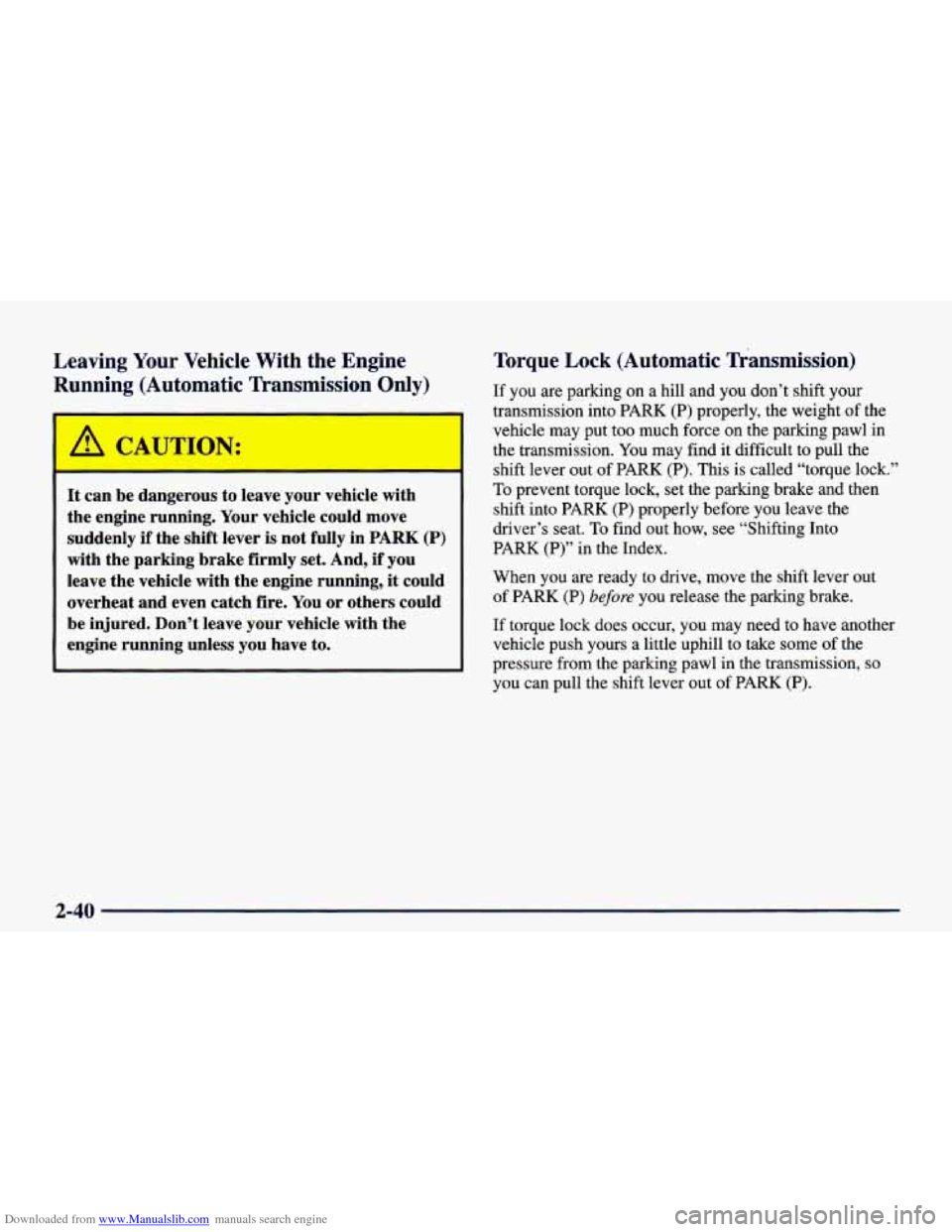
Downloaded from www.Manualslib.com manuals search engine Leaving Your Vehicle With the Engine
Rum
lg (Automatic Transmission Only)
I
It can be dangerous to leave your vehicle with
the engine running. Your vehicle could move
suddenly if the shift lever is not fully in PARK
(P)
with the parking brake firmly set. And, if you
leave the vehicle with the engine running, it could
overheat and even catch fire. You
or others could
be injured. Don’t leave your vehicle with the
engine running unless you have to.
Torque Lock (Automatic Transmission)
If you are parking on a hill and you don’t shift your
transmission into PARK
(P) properly, the weight of the
vehicle may put too much force on the parking pawl in
the transmission. You may find it difficult to pull the
shift lever out
of PARK (P). This is called “torque lock.”
To prevent torque lock, set the parking brake and then
shift into PARK (P) properly before you leave the
driver’s seat.
To find out how, see “Shifting Into
PARK (P)” in the Index.
When you are ready to drive, move the shift lever out
of PARK (P) before you release the parking brake.
If torque lock does occur, you may need to have another
vehicle push yours a little uphill to take some of the
pressure from the parking pawl in the transmission,
so
you can pull the shift lever out of PARK (P).
2-40
Page 110 of 402
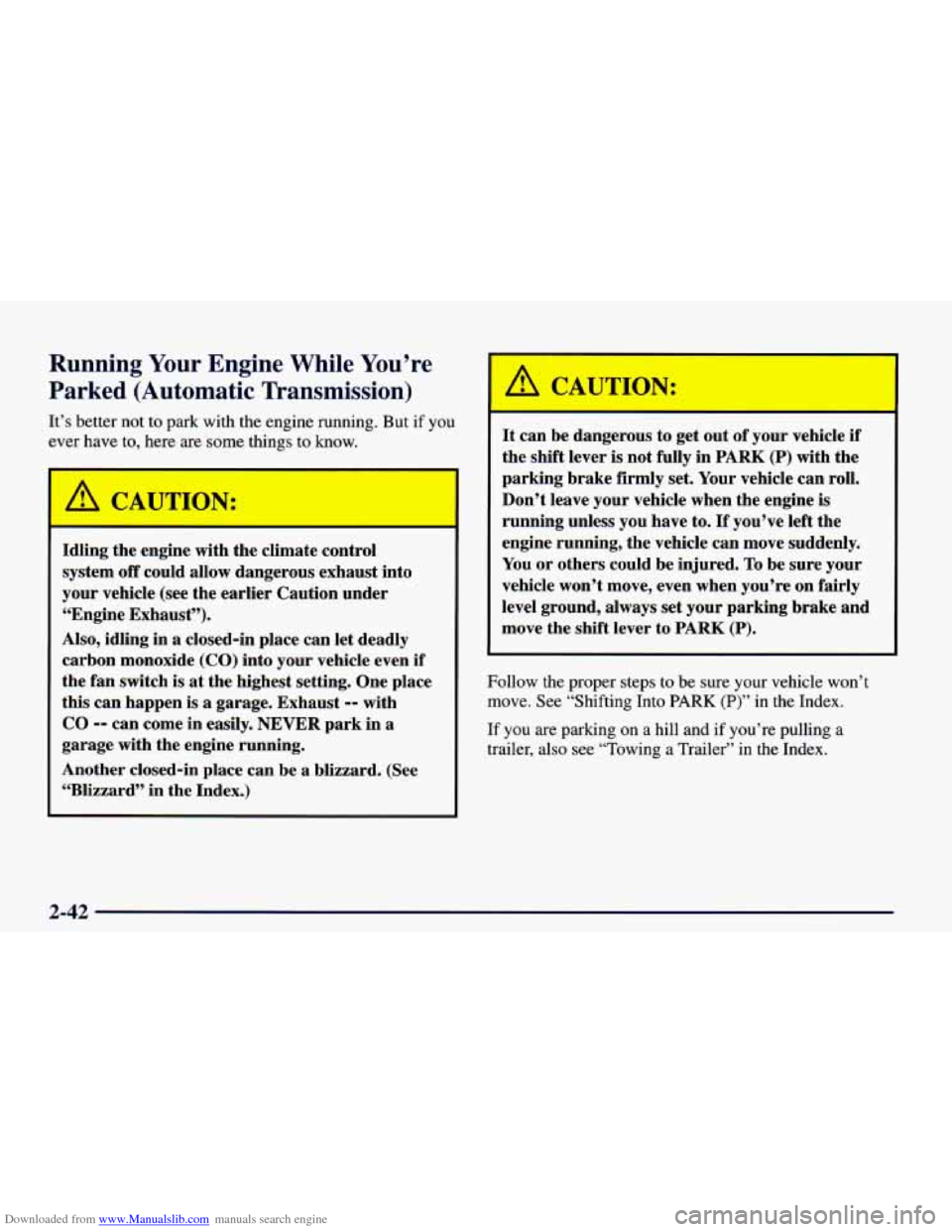
Downloaded from www.Manualslib.com manuals search engine Running Your Engine While You’re
Parked (Automatic Transmission)
It’s better not to park with the engine running. But if you
ever have to, here are some things to know.
Idling the engine with the climate control
system
off could allow dangerous exhaust into
your vehicle (see the earlier Caution under
“Engine Exhaust”).
Also, idling in a closed-in place can let deadly
carbon monoxide
(CO) into your vehicle even if
the fan switch is at the highest setting. One place
this can happen is
a garage. Exhaust -- with
CO -- can come in easily. NEVER park in a
garage with the engine running.
Another closed-in place can be a blizzard. (See
“Blizzard” in the Index.)
A -AUTION:
It can be dangerous to get out of your vehicle if
the shift lever is not fully in PARK (P) with the
parking brake firmly set. Your vehicle can roll.
Don’t leave your vehicle when the engine is
running unless you have
to. If you’ve left the
engine running, the vehicle can move suddenly.
You or others could be injured.
To be sure your
vehicle won’t move, even when you’re on fairly
level ground, always set your parking brake and
move the shift lever to
PARK (P).
Follow the proper steps to be sure your vehicle won’t
move. See “Shifting Into
PARK (P)” in the Index.
If you are parking on a hill and if you’re pulling a
trailer, also see “Towing a Trailer” in the Index.
2-42